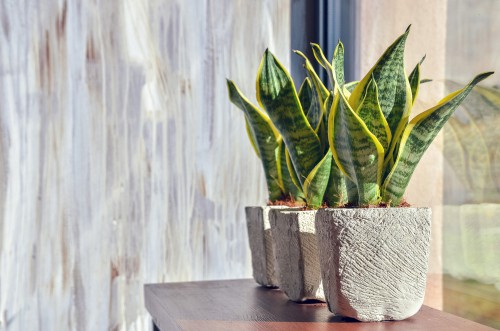Snake plants are a popular houseplant because of their easy maintenance and air-purifying qualities. However, some snake plant owners may notice holes in their plant’s leaves. This can be a cause for concern and may indicate a problem with the plant’s health.
There are several reasons why snake plant have holes in their leaves. One common cause is insect infestation. Insects are attracted to the plant’s leaves because they are a source of food.
When an insect eats a leaf, it causes a hole. Snails may also be attracted to snake plants because of their moisture. Overwatering or underwatering can also cause holes in snake plant leaves.
Understanding the causes of holes in snake plant leaves is crucial to maintaining the plant’s health. By recognizing the symptoms of snake plant problems, owners can take preventative measures to keep their plants healthy.
Proper snake plant care, including regular watering and pest control, can help prevent holes from forming in the leaves. In cases where the plant is already experiencing problems, fixing the underlying issue can help the plant recover.
Key Takeaways
- Holes in snake plant leaves can be caused by insect infestation, overwatering, or underwatering.
- Recognizing the symptoms of snake plant problems is important for maintaining plant health.
- Proper care and preventative measures can help keep snake plants healthy and prevent holes from forming in the leaves.
Learn more about plant care from these other top posts:
- Why Does My Snake Plant Have Brown Tips?
- Why Does My Rubber Plant Have Brown Spots?
- Why Does My Prayer Plant Have Yellow Leaves?
Understanding Snake Plant
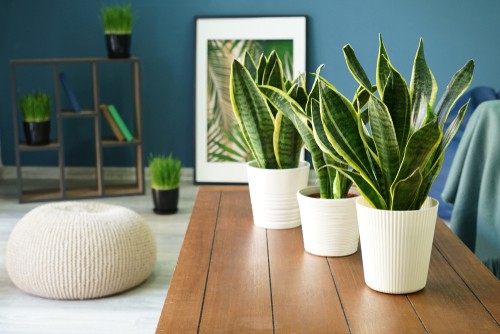
Snake plant, also known as Sansevieria or Dracaena trifasciata, is a popular houseplant that belongs to the Asparagus family. It is native to West Africa and is a tropical plant that can grow up to 3-4 feet tall.
Snake plants are known for their long, sword-shaped leaves that grow upright and are usually green or variegated with yellow or white stripes.
One of the reasons why snake plants are so popular is because they are easy to care for and can thrive in a variety of environments. They are considered succulents, which means they store water in their leaves and can tolerate periods of drought. This makes them a great choice for beginners or those who may not have a green thumb.
Snake plants are also known for their air-purifying properties. They are able to remove toxins such as benzene, formaldehyde, and trichloroethylene from the air, making them a great addition to any indoor space.
Despite their hardiness, snake plants can still experience issues such as holes in their leaves. This can be caused by a variety of factors, including insect infestations, overwatering, or snails.
Why Does My Snake Plant Have Holes – 4 Common Problems
Snake plants are hardy and easy to care for, but like any houseplant, they can develop problems. Here are some common issues that snake plant owners may encounter:
1. Overwatering and Underwatering
One of the most common problems with snake plants is overwatering. Snake plants are succulent-like, meaning they store water in their leaves. As a result, they can go for weeks without watering. Overwatering can lead to root rot, which can cause the leaves to turn yellow and mushy.
On the other hand, underwatering can also cause problems. If the soil becomes too dry, the leaves may become droopy and wilted. It’s essential to find a balance between watering too much and not enough.
2. Temperature and Humidity Issues
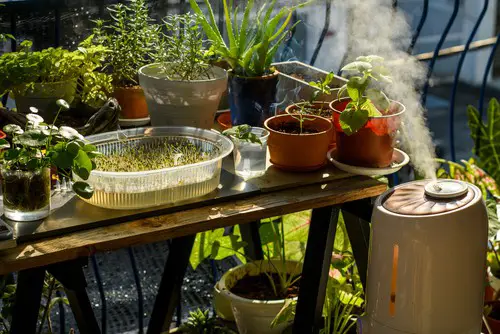
Snake plants prefer temperatures between 60 and 85 degrees Fahrenheit. If the temperature drops below 50 degrees, the plant may suffer. High humidity is not necessary for snake plants, but they can benefit from occasional misting.
3. Pest Infestation
Insects such as thrips, mites, and mealybugs can infest snake plants. They can cause leaf discoloration, holes, and damage to the plant. Snails and slugs may also be attracted to the plant’s moisture, causing holes in the leaves.
4. Disease and Fungal Infections
Fungal infections can occur in snake plants if the soil is too moist or the plant is in a humid environment. Symptoms of fungal infections include brown spots on the leaves and stem rot. It’s essential to ensure the soil is well-draining and avoid overwatering to prevent fungal infections.
Recognizing Symptoms of Snake Plant Problems
Snake plants are generally low-maintenance and easy to care for, but they can still experience problems. Recognizing the symptoms of these problems early on can help you take action to save your plant. Here are some common symptoms of snake plant problems to look out for:
1. Holes in Leaves
If you notice holes in your snake plant’s leaves, it could be a sign of insect damage. Common culprits include spider mites, mealybugs, and scale insects. These pests can be difficult to spot, but you may notice small webs or cottony masses on the leaves.
To get rid of the pests, wipe down the leaves with a damp cloth or use an insecticidal soap. If the damage is severe, you may need to prune the affected leaves.
2. Drooping and Yellowing Leaves
Drooping or yellowing leaves can be a sign of overwatering or underwatering. Snake plants are drought-tolerant and can go for long periods without water, so it’s important not to overwater them. If the soil is consistently damp, try watering less frequently.
If the soil is dry, try watering more often. In some cases, yellowing leaves can also be a sign of nutrient deficiencies. Consider fertilizing your plant with a balanced fertilizer.
3. Soft and Mushy Leaves
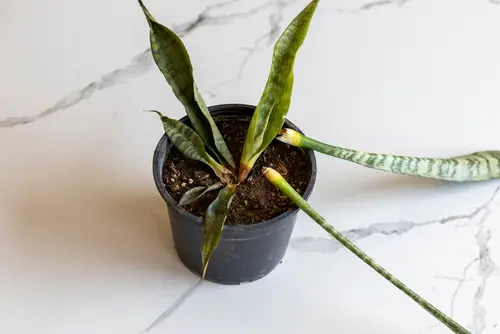
Soft and mushy leaves can be a sign of root rot, which is caused by overwatering. If you suspect root rot, remove the plant from its pot and inspect the roots. Healthy roots should be firm and white, while rotted roots will be brown and mushy. If you see signs of root rot, remove the affected roots and repot the plant in fresh soil.
4. Deformed or Misshapen Leaves
Deformed or misshapen leaves can be a sign of insect damage or disease. Check the leaves for signs of pests or discoloration. In some cases, misshapen leaves can also be a sign of environmental stress. Make sure your plant is getting enough light and is not exposed to extreme temperatures.
By recognizing these symptoms of snake plant problems, you can take action to keep your plant healthy and thriving. Remember to always inspect your plant regularly and address any issues as soon as possible.
Preventing Snake Plant Problems
Snake plants are generally easy to care for and maintain, but they can still experience problems if not cared for properly. By following a few simple guidelines, you can prevent most of the common issues associated with snake plants.
1. Proper Watering
One of the most common problems with snake plants is overwatering. Overwatering can lead to root rot, which can eventually kill the plant. To prevent overwatering, make sure the soil is completely dry before watering again. It is better to underwater than overwater snake plants.
On the other hand, underwatering can also cause problems for snake plants. If the soil is too dry, the leaves will start to droop and eventually turn yellow. To prevent underwatering, make sure to water the plant thoroughly when the soil is dry to the touch.
2. Temperature and Humidity Control
Snake plants are tolerant of a wide range of temperatures, but they prefer temperatures between 60-85°F. If the temperature drops below 50°F, the plant may experience cold damage. To prevent cold damage, keep the plant away from cold drafts and windows during the winter months.
Humidity is not a major concern for snake plants, as they can tolerate low humidity environments. However, if the air is too dry, the leaves may start to curl or brown at the tips. To prevent this, mist the leaves occasionally or place a humidifier nearby.
3. Pest Control

Pest infestations can be a major problem for snake plants. Common pests include spider mites, mealybugs, and scale insects. To prevent pest infestations, inspect the plant regularly for signs of pests, such as webs or sticky residue on the leaves. If you notice an infestation, isolate the plant and treat it with an insecticide or neem oil.
4. Disease Prevention
Snake plants can be susceptible to fungal diseases, such as root rot and leaf spot. To prevent fungal diseases, make sure the soil is well-draining and avoid overwatering. If you notice any signs of fungal disease, such as brown spots on the leaves or soft, mushy roots, treat the plant with a fungicide.
By following these simple guidelines, you can prevent most of the common problems associated with snake plants. With proper care, your snake plant will thrive and add a touch of green to your home or office.
Fixing Snake Plant Problems
Snake plants are generally easy to care for, but they can still experience problems. In this section, we’ll discuss some common issues that snake plants can face and how to fix them.
1. Repotting and Pruning
If your snake plant is experiencing problems, it may be time to repot or prune it. Repotting can help refresh the soil and provide more room for the plant’s roots to grow. Pruning can help remove any damaged or diseased leaves and encourage new growth.
When repotting, make sure to use a well-draining potting mix and a pot with drainage holes. This will help prevent root rot and ensure that the plant’s roots don’t sit in water. Pruning should be done with clean, sharp scissors or shears. Make sure to cut at a 45-degree angle to prevent water from pooling on the cut.
2. Fertilizing and Nutrient Balance
Snake plants don’t require a lot of fertilizer, but they do need some nutrients to grow and thrive. If your snake plant is looking pale or weak, it may be time to fertilize. Use a balanced fertilizer, such as a 10-10-10 or 20-20-20, and follow the instructions on the package.
It’s important to maintain a proper balance of nutrients in the soil. Too much fertilizer can lead to salt buildup and damage the plant’s roots. Use a moisture meter to check the soil’s moisture level and adjust your watering and fertilizing accordingly.
3. Drainage and Soil Moisture Control
As mentioned earlier, snake plants need well-draining soil and a pot with drainage holes. This will help prevent root rot and ensure that the plant’s roots don’t sit in water. Use a soil moisture meter to check the soil’s moisture level and water only when the soil is dry to the touch.
If your snake plant is experiencing problems due to overwatering, you may need to adjust your watering schedule or use a pot with better drainage. If the soil is too dry, you may need to water more frequently or use a humidity tray to provide more moisture.
4. Light and Photosynthesis

Snake plants require bright, indirect light to photosynthesize and grow. Too much direct sunlight can scorch the leaves, while too little light can cause the leaves to droop and turn yellow.
Place your snake plant in a spot that receives bright, indirect light. If your plant is not getting enough light, consider moving it closer to a window or using a grow light to supplement natural light.
By following these tips, you can help fix common problems that snake plants may experience. Remember to always monitor your plant’s soil moisture, light exposure, and nutrient balance to ensure that it stays healthy and happy.
Proper Snake Plant Care
Snake plants are relatively low-maintenance houseplants, but they still require proper care to thrive. In this section, we will cover some essential aspects of snake plant care, including ideal potting mix, propagating snake plants, and cleaning and maintenance.
1. Ideal Potting Mix
Choosing the right potting mix is crucial for the health and growth of your snake plant. A well-draining mix that is rich in minerals is ideal. You can make your own mix by combining equal parts of gravel, perlite, vermiculite, and coarse sand. Alternatively, you can purchase a pre-made mix that is specifically formulated for snake plants.
When potting your snake plant, make sure to choose a pot that is slightly larger than the root ball. This will give the roots enough room to grow without drowning in excess water. It is also important to use a pot with drainage holes to prevent water from pooling at the bottom.
2. Propagating Snake Plants
Propagating snake plants is a great way to expand your collection or share your plants with friends. There are several methods of propagation, including division, leaf cuttings, and rhizome cuttings.
Division involves separating the plant into smaller sections and potting them individually. Leaf cuttings involve removing a leaf from the plant and rooting it in water or soil. Rhizome cuttings involve removing a section of the underground stem and potting it in soil.
Regardless of the method you choose, it is important to use clean, sharp tools and to provide the new plants with proper care and attention.
3. Cleaning and Maintenance
Keeping your snake plant clean and healthy is essential for its long-term success. Regularly dusting the leaves with a damp cloth or sponge will help to prevent pests and keep the plant looking its best.
You should also periodically check the soil moisture level and water the plant as needed. Overwatering can lead to root rot, while underwatering can cause the leaves to wilt and dry out.
In addition to regular cleaning and maintenance, it is also important to periodically repot your snake plant to ensure that it has enough room to grow and access to fresh soil and nutrients.
By following these simple tips for proper snake plant care, you can help your plant thrive and enjoy its many benefits for years to come.
Frequently Asked Questions
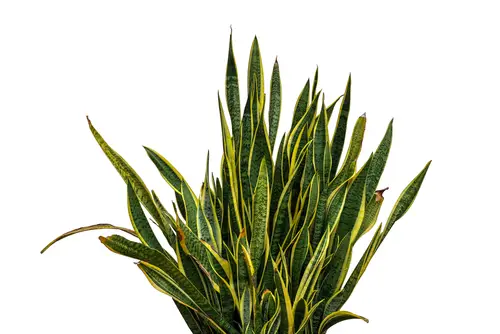
How do I treat holes in my snake plant leaves?
Treating holes in snake plant leaves depends on the underlying cause. If the holes are caused by pests, such as spider mites or snails, use an appropriate pesticide or remove the pests manually.
If the holes are caused by overwatering or underwatering, adjust the watering schedule accordingly. If the holes are caused by physical damage, such as accidental tearing or cutting, remove the affected leaves or cut off the damaged parts using a clean, sharp tool.
What causes holes in snake plant leaves?
There are several possible causes of holes in snake plant leaves.
Some of the common causes include pests, such as spider mites, snails, or mealybugs, overwatering or underwatering, physical damage, such as tearing or cutting, nutrient deficiencies, or diseases, such as bacterial or fungal infections.
Can pests cause holes in snake plant leaves?
Yes, pests such as spider mites, snails, or mealybugs can cause holes in snake plant leaves. These pests feed on the plant’s leaves and cause damage, which may appear as holes or chewed edges.
How can I prevent holes in my snake plant leaves?
To prevent holes in snake plant leaves, ensure that the plant is growing in well-draining soil and in a pot with drainage holes. Water the plant only when the soil is dry to the touch and avoid overwatering or underwatering.
Keep the plant away from direct sunlight or extreme temperatures, which can stress the plant and make it more susceptible to pests and diseases. Inspect the plant regularly for signs of pests or diseases and take prompt action to treat them.
Are holes in snake plant leaves a sign of disease?
Holes in snake plant leaves can be a sign of disease, especially if they are accompanied by other symptoms such as yellowing, wilting, or blackening. Diseases such as bacterial or fungal infections can cause holes in the leaves, which may appear as irregular or circular lesions.
Is it normal for snake plant leaves to have holes?
It is not normal for snake plant leaves to have holes, but it can happen due to various reasons such as pests, physical damage, or diseases. If the holes are minor and do not affect the overall health of the plant, they may not require treatment.
However, if the holes are extensive or accompanied by other symptoms, take prompt action to identify and treat the underlying cause.

Hey, I’m Lisa and I’ve been an avid gardener for over 30 years. I love writing, talking and living in the garden! Feel free to connect with me on my socials below

